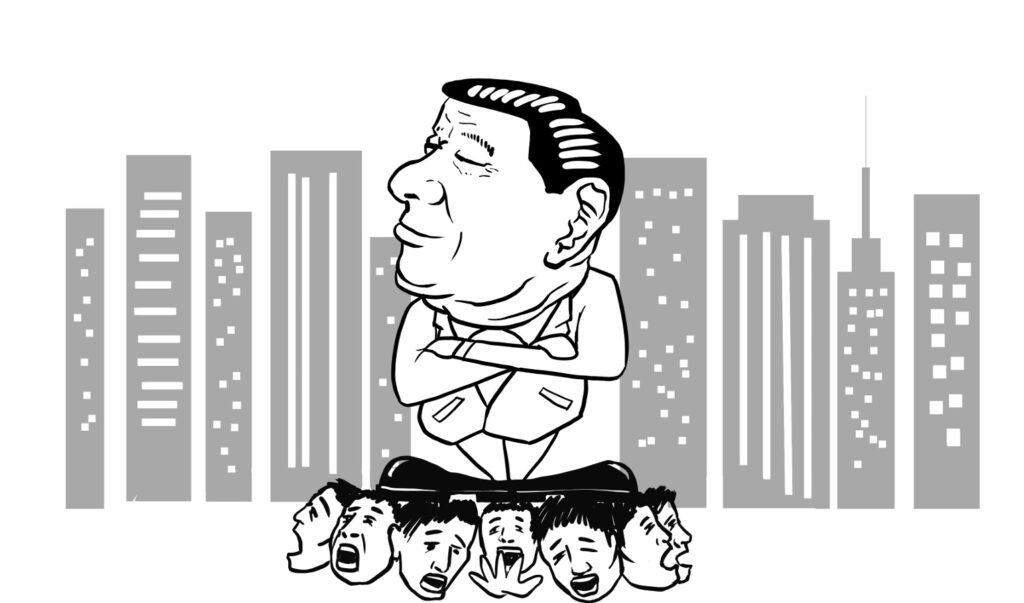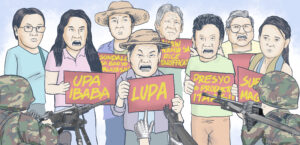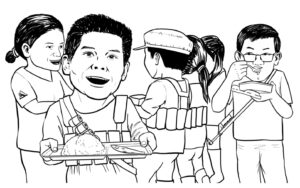The face of capitalism in China


In commemoration of the 70th founding anniversary of the People’s Republic of China (PRC) last October 1, China paraded new weapons and its armed forces to flaunt its imperialist might. Like in its trade war, China is demonstrating to big capitalist countries, especially the US, that it is prepared to engage in the intensifying inter-imperialist conflict, while aspiring to expand its influence and control across the world.
In the past years, China has significantly upgraded its armed forces. According to its official statement, this is to protect the country’s internal interests (including territories it has unilaterally claimed such as the South China Sea), and its expanding and increasing external interests.
This is what China has fallen to since it followed the exploitative and oppressive capitalist path. Contrary to what is being projected by its leaders, this has not been implemented peacefully nor magnanimously. In reality, China has imposed this transformation by comprehensively exploiting and suppressing millions of its citizens, and by extensively and thoroughly destroying the socialist society and economy.
The leadership of the Communist Party of China (CPC) cannot conceal its treachery to the proletariat, the current dominance of monopoly capitalism in China, and its undertaking of measures which can be considered as imperialist aggression.
Its socialist rhetorics and declaration that it remains a socialist nation “with Chinese characteristics” are but a thin veil which disguises China as different to other western capitalist countries. It preserved the external structure of the communist party, along with the people’s congresses and councils. In reality, however, the state is dominated by monopoly capitalists within and outside the Party, and their foreign counterparts.
Dismantling collective land ownership and cultivation
One of the first and worst measures implemented by the revisionists who took over the CPC to destroy the socialist system was the dismantling of collective land ownership, administration and cultivation. In the late 1970s, the Chinese leadership began to implement “decollectivization” which passed on the responsibility of commune committees to produce and farm to individual families. Although the communes retained land ownership, individual farmers were given the right to cultivate these for 15 years, which was later extended to 30 years. Under the socialist China, the communes were organized as a form of public property wherein land is owned by the state and large communes, production is collectively decided upon and managed by communes, and resources and wealth benefit the entire populace.
Small communes consist of 5,000 households, while large ones can consist up to 20,000 households.
Contrary to the propaganda of the CPC that the people “eagerly” and “voluntarily” accepted decollectivization, the resistance of peasants and low-ranking Party cadres against the said policy was extensive. The resistance was strongest in the most developed towns at that time including Shanghai, Beijing and Yunnan, which later became centers of capitalist production of local and foreign monopolies. Nevertheless, by using the state machinery, decollectivization was implemented and the small and separate production of farmers was restored. On average, only 0.64 hectare is owned and tilled by each farmer.
By 2002, China changed its land use policy and implemented the reconcentration of land, but only in the hands of a few. Due to urbanization, it allowed the massive grabbing of lands owned by communes and individual farmers by private business and commercial plantations. China gave its bureaucrats in the government the authority to seize agricultural lands and transform these into industrial, commercial or tourism uses. In 2008, China allowed the unrestricted selling and the use of the rights of individual farmers to till as collateral. In 2016, 20% of agricultural lands were already concentrated in the hands of private companies and individuals, while 5% remained formally owned by the state.
This policy paved the way for the privatization and reconcentration of millions of hectares of land in the hands of local and foreign companies. Decollectivization, and later on, privatization, corroded the worker-peasant class alliance, the unity in the countryside and the urban centers, and the balanced development of agriculture and industry. Chinese peasants, who served as the primary force of the socialist construction, lost their political and economic power.
With the dismantling of communes, hunger became prevalent because the production of sufficient food and the maximization of resources were not ensured. Support mechanism, such as market cooperatives, were dissolved. No subsidies and incentives were provided to supplant the said mechanisms. In the following years, many farmers were compelled to stop farming due to high production costs, especially after the state stopped imposing controls on prices of fertilizer and seedlings.
With the dismantling of communes, the services these provide such as health and education simultaneously ended. During the period of socialist construction, 85% of families in the countryside benefited from health services, primarily under the barefoot doctors system. By 2010, the said statistics has been reversed (80% were without access to health services). Similarly in the 1970s, 70% of the youth in the countryside graduated from high school. This plunged to 10% by the end of the 1990s.
Data by the United Nations indicate that approximately 750 million in the countryside in China survive with only less than $2/day (P100). Many of those who work in the cities are not officially counted as residents (approximately 250 million), and thus, are denied social services. Since the 1980s, China’s wage gap in its rural and urban areas is the highest in the world.
Privatization of industry
Evicted from their lands, farmers were forced to migrate to cities to search for jobs. They squeezed themselves in the already dense city spaces, and compete for jobs with low wages and inhumane working conditions.
Approximately 150 million farmers migrated to the cities since the early 1980s due to decollectivization in the countryside. They became the pool of cheap labor exploited by local and foreign companies. In the labor force, the number of non-agricultural workers rose from 31% in the 1980s, to 50% in 2000, and 60% in 2008. This is expected to reach 70% by 2020.
In the 1990s, China implemented the massive privatization of public industries. Almost all small and medium-scale businesses, and some large public factories, were sold at extremely low prices or practically given away to private entities. Many government officials (including corrupt “Party cadres”), managers of various businesses, and capitalists with connection to the CPC benefited from this measure. They became the new capitalists of the Chinese society. They were able to drastically increase their capital through plundering public properties and businesses, and exploiting the cheap labor of the toiling masses. These capitalists plundered up to 30 trillion yuan (or P217 trillion at 1 yuan=P7) worth of state properties.
Since the 1980s, China has opened the Chinese economy to foreign plunder. It established special export processing zones where foreign capitalists were able to build their factories, without paying taxes and without having to follow labor laws, and enjoy other similar incentives. Last March, the Chinese congress passed a new foreign investment law which opened the whole economy of the country to foreign capital and plunder. The said law will take effect in January 2020.
In public factories, tens of millions of workers lost their jobs and were beset in poverty due to policies implemented by new capitalists in the name of “modernization.” Using advanced capitalist countries as model, the new capitalists dismantled guarantees and benefits gained and fought for during the socialist construction. Managers and capitalists were given the authority to hire and dismiss workers. The old collective system of raising productivity was replaced with material incentives. Socialist guarantees, including the security of tenure, pension, maternity leave, and many other educational and health benefits, were dismantled. In 1982, the right to strike, a right upheld by Chinese revolutionaries, was removed from the country’s constitution. As in the countryside, workers broadly and vehemently opposed this scheme.
Because of these policies, Chinese workers now endure extremely low wages and benefits, longer working hours, hazardous workplaces and other problems. Senior workers were able to fight for their right to security of tenure and benefits in public factories, but majority of new workers are now employed as contractuals. In export processing zones, workers work up to 12 hours per day, and seven days a week. They live in crammed dormitories which charge high water and power rates. There are instances when workers are forced to work up to 15 hours day, and are called to duty in the factory by capitalists anytime of the day.



